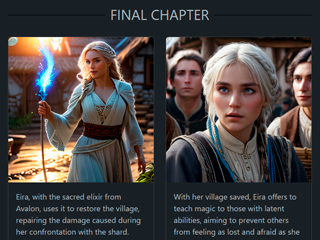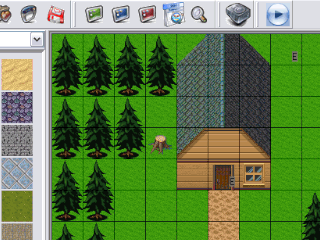This page presents an overview of my research projects, covering early work on game development tools through current research on AI-powered narrative generation and procedural content creation for games.
Current Research
Generative AI for Interactive Storytelling
Generative AI models have shown remarkable capabilities in creating diverse content, including text, images, and voices. However, Large Language Models often struggle to maintain thematic consistency and structure when used for narrative generation, especially when creating longer and more complex stories. This project explores new methods to guide the generation of narratives using AI, by incorporating narrative patterns, genre structures, and semiotic relations, to improve the overall quality and coherence of the generated stories.
Read more →Narrative Generation Methods for Games
Quests are a fundamental storytelling mechanism used by computer role-playing games (RPGs) to engage and involve players in the game's narrative. Although RPGs have evolved in many ways in recent years, their basic narrative structure is still based on static plots manually created by game designers. This project explores the generation of dynamic and interactive quests for games using hierarchical task decomposition, planning under nondeterminism, player modeling, and genetic algorithms.
Read more →Previous Research
Adaptive Horror Games
Fear is a basic human emotion that can be triggered by different situations, which vary from person to person. However, game developers usually design horror games based on a general knowledge of what most players fear, which does not guarantee a satisfying horror experience for everyone. This project explores new methods to create adaptive horror games by using player modeling techniques to identify what individual players fear and adapt the content of the game to intensify the fear evoked in players.
Read more →Computational Narratology and Storytelling Variants
An intriguing phenomenon in human storytelling is our ability to still recognize a story that the narrator has felt free to change to a considerable extent. However, observing how folktales have appeared and been disseminated through different countries over the centuries, we shall notice that our favorite stories have evolved no less dramatically in the course of the oral storytelling tradition. Founded on the classification of types and motifs contained in the Antti Aarne and Stith Thompson Index, this research project attempts to understand how narrative variants emerge in order to create new narrative generation methods.
Read more →Preference Modeling for Adaptive Storytelling
In almost all forms of storytelling, the background and current state of mind of the audience members predispose them to experience a given story from a uniquely personal perspective. However, traditional story writers usually construct their narratives based on the average preferences of their audience, which does not guarantee satisfying narrative experiences for its members. This project explores user modeling and adaptive storytelling to generate individualized interactive narratives based on the preferences of users.
Read more →Video-Based Interactive Storytelling
The generation of engaging visual representations for interactive storytelling represents a key challenge for the evolution and popularization of interactive narratives. Usually, interactive storytelling systems adopt computer graphics to represent the virtual story worlds, which facilitates the dynamic generation of visual content. Although animation is a powerful storytelling medium, live-action films still attract more attention from the general public. This project explores a new approach to create more engaging interactive narratives, where characters and virtual environments are replaced by real actors and settings.
Read more →Paper and Pencil Interactive Storytelling
In this project, we explore the use of an augmented reality visualization interface combined with a sketch-based interaction interface. We present a storytelling system able to dramatize interactive narratives in augmented reality over a conventional sheet of paper. The system allows users to freely interact with virtual characters by sketching objects on the paper. The system recognizes the hand-drawn sketches and converts the drawings into virtual objects in the 3D story world.
Read more →Interaction Methods for Interactive Storytelling
In recent years, interactive narratives have emerged as a new form of digital entertainment, allowing users to interact and change stories according to their own desires. However, designing an interaction model for an interactive storytelling system involves several challenges, including the need for natural interaction interfaces and the ability to handle multi-user interactions. This project explores the development and evaluation of several interaction methods for interactive storytelling systems.
Read more →Virtual Cinematography for Interactive Storytelling
Many of the challenges that are faced today during the development of interactive storytelling systems have been addressed before by filmmakers. Over the years, cinema has evolved and established various principles and rules to be adopted during the creation of a film. However, unlike movies, where every scene is carefully planned, interactive storytelling does not have this freedom. This project explores the use of autonomous agents inspired by cinematography to dramatize interactive narratives.
Read more →Indie Games: Krimson & Warped Metal
Krimson and Warped Metal are two games that I created to participate in an indie game development festival at SBGames 2010. Krimson tells the story of a dragon named Krimson, who was imprisoned by people many years ago. Now the dragon has awakened and wants revenge! Warped Metal is a car battle game where the only thing that matters is to survive and destroy the opponents' cars. The game includes several cars, weapons, and power-ups.
Read more →3D Game Builder
This was my final undergraduate project in computer science. The goal of the project was to create a 3D game engine to make it easy to people without experience in programming languages to create their own 3D games. The 3D game engine created, called 3D Game Builder, became a success in the Brazilian independent game development community and had more than 5.000 downloads in the first week after the release of the first version.
Read more →RPG Builder
The goal of this project was to make it easy for people without experience in programming languages to create their own 2D games. The game engine created, called RPG Builder, is a tool for creating 2D role-playing games. The project was funded by FAPESC (Fundação de Apoio à Pesquisa Científica e Tecnológica do Estado de Santa Catarina). To validate the tool, an educational RPG was created, which tells historical facts about the Contestado War. In the game, players can experience and understand more clearly the events that occurred during the Contestado War.
Read more →











